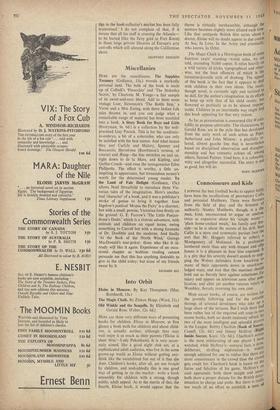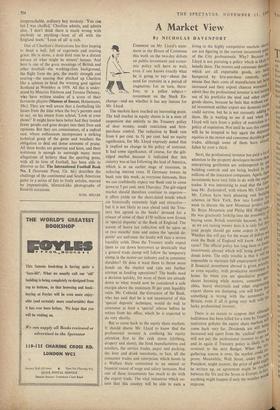Connoisseurs and Kids
I SUPPOSE the best football books to appear lately have been the recollections of peremptory Cull's and perennial Matthews. There were flavours, from the field of play and the firmness 01 authority. Stanley Matthews, though, is a shy man, kind, unconcerned td argue or analyse, twice as expansive about his 'simple wants 'plain home-cooked meals,' his family and fire" side—as he is about the secrets of his skill. Stan Cullis is a stern and systematic puritan (not the sort that Mr. Hoggart referred to either), a Montgomery of Molineux. In a profession lumbered more than any with blatant and silly bosses it is a pleasure to hear him expound. It is a pity that his severity doesn't stretch to stop' ping the Wolves defenders from knocking a° many of their opponents down in unacknow- ledged ways, and nice that this martinet should hold out so fiercely here against substitutes for injury and appear on television soon after Pub, lication, and after yet another ruinous injury at Wembley, fiercely reversing his own case.
Most soccer books, of course, are written for the juvenile following and for the amiable throngs of arrested developers who take up large share of the terraces. But I wish there had been rather less of the required soft soap in two „ recent books, both no doubt zealously edited, by two of the most intelligent and splendid players in the League: Bobby Charlton (Book of Soccer' Cassell, 12s. 6d.) and Jimmy Mcllroy (9011 Inside Soccer, Kaye, 12s. 6d.). Charlton's action is the most exhilarating of any player I have watched, while McIlroy's—samurai face, a slow'deliberate, strolling exploration—is widely enough admired for one to realise that there are, more connoisseurs in the-crowd than the crowd gets credit for. Charlton's book is based on the furies and felicities of his game, McIlroy's on cool appraisals; both show insight and sense, both show a proper distaste for the British deter' mination to charge and jostle. But there is real too much of an effort to establish a tone of irreproachable, ordinary boy modesty. 'You can bet I was chuffed,' Charlton admits, and admits also, 'I don't think there is much wrong with anybody or anything—least of all with the England team.' Least of all' is rich.
One of Charlton's illustrations has him leaping to head a ball, full of eagerness and soaring grace. He is alone, a drab field runs to a distant terrace of what might be miners' houses. And here is one of the great meanings of British and other football—the working-class background, the flight from the pits, the manly strength and soaring—the soaring that plucked up Charlton like a salmon to head the winning goal against Scotland at Wembley in 1959. All this is under- stood by Maurice Edelston and Terence Delaney, who have written studies of a score of their favourite players (Masters of Soccer, Heinemann, 18s.). They are well aware that a footballing life issues from the time when the boy's parents used to say, on his return from school, 'Look at your shoes!' It might have been better had they treated fewer people and gone deeper into their lives and opinions. But they are connoisseurs, of a radical cast, whose enthusiasm incorporates a striking technical grasp of the game and weathers the obligation to deal out dense amounts of praise. All three books are generous and keen, and their testimony is enough to outweigh many more allegations of bribery than the sporting press, with all its love of football, has been able to discover so far. The International Football Book No. 2 (Souvenir Press, 12s. 6d.) describes the challenge of the continental and South American game in a series of fair to lively articles, marred by impenetrable, blizzard-like photographs of flood-lit occasions.
KARL MILLER















































 Previous page
Previous page